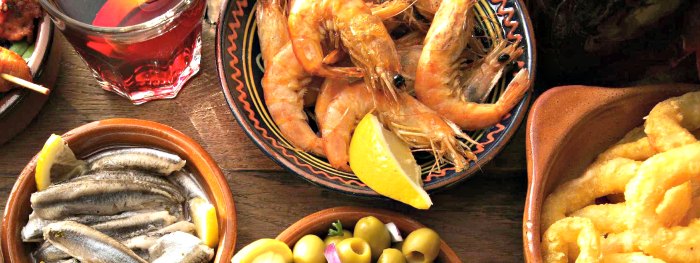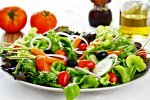Boquerones en escabeche
This is an old, old way of preserving small fish which has survived into modern times because it is so delicious. The coast round Nerja is known for its shoals of fresh anchovies.
In Malaga the fish are pressed together into a little fan, four tails together, for frying, but this is not essential to the recipe.
- Serves 8
- Difficulty: intermediate

Ingredients
- 2 lb. fresh anchovies, sardines or smelts.
- 6-8 tablespoons olive oil
- 2 oz. flour
- Salt and freshly ground black pepper
- 6 garlic cloves, finely chopped
- 1 small pinch of spanish saffron strands
- 1 teaspoon cumin seeds
- 1 teaspoon ground ginger
- 9 fl. oz sherry vinegar
- 4 bay leaves
- 1 lemon, thinly sliced
Preparation
Cut off the fish heads, pulling out their innards. Slit them down the belly, as far as the tail, and swish the insdes under a tap.
Then put each fish down on a board, black back upwards, and press a thumb firmly down on it. This opens it out like a book and makes it easy to rip out the backbone and tail.
Heat 4 tablespoons of olive oil in a big frying pan. Dust the fish with seasoned flour on a baking tray and fry immediately you have a trayful (there will be about 4 of these).
Put them in skin-side down and turn after 1-2 minutes. Remove them to kitchen paper to drain. Take the pan off the heat between batches and add more olive oil as necessary.
Fry the garlic in the remaining olive oil, then move to a mortar or a small herb (or coffee) mill. Work to a paste with a pinch of salt, the saffron, cumin seeds and ginger. Work in the vinegar.
Arrange the fish in an earthware dish, skin up. This can be shallow if you are planning to serve them within 24 hours, but should be smalller and deeper if you want to keep them.
Mix 9 fl. oz of water into the spicy mixture and pour this over the fish. Add more vinegar and water to cover them completely if you are keeping them.
Lay the bay leaves and very thinly sliced lemon over the top. Refrigerate for half a day before eating. They can be served straight from the dish, and eaten before a week.
You may be also interested in...
See also...
Andalusia recipes: The Romans taught the Andalusians how to cultivate wheat and vines and used the fish from the seas to produce the best "garum" in the empire. The Arabs taught the Andalusians how to grow fruit and vegetables. They used irrigation systems and improved the cultivation of olive trees and the production of oil. Furthermore, the Greeks, Phoenicians, Carthaginians and Visigoths left their mark on the art, science, culture and gastronomy of Andalusia.
Tapas are Spain's greatest food invention. "Eat when you drink, drink when you eat" is the philosophy. Spanish men traditionally drink outside the home and rarely alone. They are not meant to be a meal (although a ración is a substantial portion). One tapa per person and a different one with each drink is the idea, then everyone enjoys tasting and sharing.




